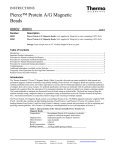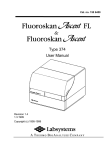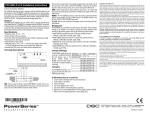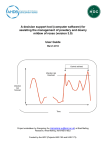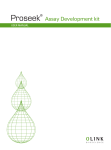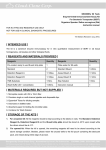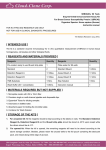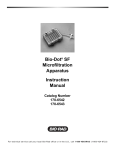Download KIT Insert
Transcript
Product no. 03-96 Protein A ELISA Instruction Manual for samples with or without IgG IMMUNSYSTEM I.M.S. AB www.immunsystem.com Edition Edition090811M_draft KI-090921M All Copyright©©IMMUNSYSTEM IMMUNSYSTEMI.M.S. I.M.S. AB Allrights rights reserved. reserved. Copyright AB Instruction manual for Protein A ELISA kit IMMUNSYSTEM, Product No 03-96 Table of content 1. 2. 3. 4. 5. 6. 7. 8. 9. 10. 11. 12. 13. 14. 15. 16. 1. Background ...................................................................... 2 Assay principle ................................................................. 4 Kit contents....................................................................... 5 Materials not provided ...................................................... 6 Precautions ....................................................................... 6 Reagent preparation .......................................................... 7 Sample and standard preparation ....................................... 8 Test procedure ................................................................ 10 Analysis of results ........................................................... 12 Performance .................................................................... 13 Tips and hints ................................................................. 16 Related products ............................................................. 16 References ...................................................................... 17 Quick start guide, samples without IgG ........................... 18 Quick start guide, samples with IgG ................................ 19 Contact and order information......................................... 20 Background 1.1 Staphylococcal Protein A (SpA) SpA is an immunoglobulin (IgG)-binding protein found in the bacterial cell wall of Staphylococcus aureus (ref 1). SpA binds to most mammalian IgG and can be used for detection or purification of such antibodies (ref 2). Affinity chromatography on SpA columns is widely used for the purification of monoclonal and polyclonal antibodies. SpA may sometimes leak from the column and contaminate the preparation which may give false results in immunological assays. In the in vivo setting, SpA can react with IgG causing anaphylactic reactions (ref 1). Thus, it is important that antibody preparations are free from SpA before being used. Page 2 of 20 Instruction manual for Protein A ELISA kit IMMUNSYSTEM, Product No 03-96 This kit has been developed and is primarily tested with recombinant SpA from GE Healthcare, which is also the source of the included SpA reference. Native SpA and other sources of recombinant SpA generally give good recoveries, but in some cases it may be necessary to use the same SpA source for the standard as for the samples being analysed. 1.2 Non-specific interactions between SpA and IgG Analysing for the presence of SpA in samples containing IgG involves two major problems which must be overcome in order to obtain reliable results. Fc binding. SpA reacts with the Fc region of IgG from most animal species which makes its specific detection by immunoassay difficult. Antibodies specific for SpA will bind specifically as well as non-specifically due to the Fc reactivity of SpA. In this kit, the problem is solved by using chicken anti-SpA IgY. Chicken antibody is one of the few immunoglobulins that does not bind SpA in the Fc region. IgG Y IgY Y IgG binds SpA nonspecifically in the Fc region. This problem is overcome using chicken IgY since it is not Fc reactive to SpA. Other non-specific interactions. In samples containing mammalian IgG, immunologically active epitopes of SpA can be blocked by non-specifically bound IgG. To overcome this problem, SpA can be analysed at low pH (ref 4) since this should cause SpA and IgG to dissociate. However, high affinity antibodies (e.g. human IgG and certain mouse monoclonals) bind to SpA even below pH 3. Unfortunately, the specific immunological detection of SpA is very difficult at such low pH and an assay at this pH would likely have an unsatisfactory analytical performance. Instead, we have chosen to establish a flexible assay system that can be tailored to each customer’s situation. The standard references are made with known amounts of IgG present. The IgG solution, which is added to the standard references, should be as similar as possible to the IgG found in the Page 3 of 20 Instruction manual for Protein A ELISA kit IMMUNSYSTEM, Product No 03-96 samples. To dissociate SpA and IgG, the samples and standard references are boiled for 4 minutes. In other words, the assay is standardised with the same IgG that is present in the samples. The possible error from the blocking of antigenic epitopes is therefore eliminated. 2. Assay principle This ELISA kit is designed to detect SpA in IgG-containing solutions (e.g. monoclonal antibody preparations), in acid eluates from SpA columns, or in other liquid preparations. It is a sandwich ELISA based on microtitre strips precoated with the primary antibody, affinity-purified chicken anti-SpA. SpA from the sample is bound to the microwell and detected by biotinylated chicken anti-SpA antibody. Next, a streptavidin horseradish peroxidase conjugate is bound to the biotin conjugate. Finally, the substrate is added and reacts with the horseradish peroxidase to produce a colour change. Colour development indicates a positive result, and the colour can be read visually or by a microplate spectrophotometer at 450 nm. Samples to be tested with this assay are often of acidic pH. In order for the test to work properly, such samples should be neutralised. If a sample contains mammalian IgG, SpA may interact with the IgG and be partially blocked, falsely lowering the signal. To avoid this problem, samples containing IgG are treated to denature the IgG and expose SpA epitopes. A schematic outline of the assay is shown. Page 4 of 20 Instruction manual for Protein A ELISA kit IMMUNSYSTEM, Product No 03-96 1 YY SpA from the sample is bound to wells precoated with the primary antibody, chicken anti-SpA IgY Incubate 1 hr. at room temperature 2 B Y YY Biotinylated chicken anti-SpA IgY is added as secondary antibody Incubate 1 hr. at room temperature Strepavidin HRP is added and binds to the biotin conjugate Incubate 30 min. at room temperature 3 B Y XX YY 4 Substrate B Y XX YY Incubate 10 min. at room temp. (dark) Coloured product Substrate is added and and reacts with HRP to produce a coloured product. Finally, stop solution is added to stop the chromogenic reaction. 3. Kit contents • Microtitre strips 8x12, precoated with chicken anti-SpA antibody. • Biotinylated anti-SpA IgY, 200 µL. 100x solution. Contains preservative. • PBS-Tween tablets, 3 tablets. Sufficient for 3x0.5 L Phosphate Buffered Saline with 0.1% Tween. • HRP Conjugate, 200 µL. Streptavidin horseradish peroxidase conjugate. 100x solution. Contains preservative. • Protein A reference, 200 µL. 0.5 mg/mL SpA solution (recombinant origin). Contains preservative. • Substrate solution, 25 mL. TMB/H2O2 solution. • Tween 20 concentrate, 2 mL. • 2 M Tris Buffer, 25 mL. • Stop solution, 20 mL. 1 M HCl. (Caution: Strong Acid) Page 5 of 20 Instruction manual for Protein A ELISA kit IMMUNSYSTEM, Product No 03-96 4. Materials not provided • Pipettes: 10 to 1,000 µL • Eppendorf tubes • Microplate spectrophotometer • 10-mL tubes • Disposable pipette tips • Ultra pure water Additional materials needed to assay samples with IgG: • SpA-free IgG solution • Centrifuge (2000g) • Water bath • Vial rack or floating aid 5. Precautions • Carefully read and follow all instructions. • Use a separate pipette tip for each sample. • Store the kit and all reagents at +2 to +8°C (35 to 45°F). • Do not pipette by mouth. • All reagents should equilibrate to room temperature +18 to +25°C (64 to 77°F) before use. • Standard references must be used for each new test series. • Unused microtitre wells should be stored sealed at +2 to +8° C. • Use only ultra pure water for preparation of reagents. • Do not mix components or instruction booklets from kits with different expiration dates (different batches). • The Substrate solution and 2 M Tris buffer are irritating to eyes, respiratory system and skin. Avoid contact with skin and eyes. • Be careful to prevent contamination of kit components. • The Stop solution contains HCl. This is a strong acid that can cause burns. Handle with care. • Do not use the kit beyond expiration date. • This kit is for research use only. • Do not eat, drink, or smoke where specimens or kit reagents are handled. Page 6 of 20 Instruction manual for Protein A ELISA kit IMMUNSYSTEM, Product No 03-96 6. Reagent preparation The examples below calculate the approximate amount needed to assay 96 microtitre wells (i.e. 12 strips). The amount of Neutralisation and Dilution buffer needed depends on the pH and concentration of the samples and therefore varies with each test. • Microtitre wells, Substrate solution and Stop solution are ready for use. • Protein A reference. Should be diluted according to step 7.4. • Tween solution. Prepare Tween solution by diluting the concentrate 1:5 in ultra pure water. Example: Mix 1 mL Tween concentrate with 4 ml water. Vortex. • Neutralisation buffer. Prepare by diluting Tween solution 1:5 in Tris Buffer. Example: Mix 1 mL Tween solution with 4 mL Tris buffer. Vortex. • Dilution buffer. Prepare by diluting Neutralisation buffer 1:10 in your acid elution buffer (i.e. sample matrix buffer). Example: Mix 1 mL Neutralisation buffer with 9 mL elution buffer. Vortex. • PBS-Tween (PBS-T) buffer. Dissolve 1 tablet in 500 mL ultra pure water. Store prepared PBS-T buffer at + 4°C but not for more than 3 days. • Biotinylated anti-SpA IgY Concentrate. Dilute 1:100 in PBS-T buffer. The solution is not stable for more than 24 hours. Example: Mix 120 µL Biotinylated anti-SpA IgY Concentrate with 12 mL PBS-T buffer. Vortex. • HRP conjugate Concentrate. Dilute 1:100 in PBS-T buffer. The solution is not stable for more than 24 hours. Example: Mix 120 µL HRP conjugate Concentrate with 12 mL PBS-T buffer. Vortex. Page 7 of 20 Instruction manual for Protein A ELISA kit IMMUNSYSTEM, Product No 03-96 7. Sample and standard preparation After reagent preparation, the samples and standard references are prepared before the assay is performed. The steps for sample preparation and test procedure are also summarised in the Quick Start Guides on pages 18 and 19. 7.1 Preparing samples (samples with and without IgG): Neutral samples: SpA easily binds to glass and plastic material. However, in the presence of 0.05% Tween 20 this binding is inhibited. In order to avoid this, add Tween solution, 1:400, to the sample tubes before adding sample. Next, add sample and mix well. Example: For 2 mL sample volume, add 5 µL Tween solution. Acidic samples: Samples should be neutralised to improve the specific immunological detection of SpA. Determine the elution volume of your acid eluted samples. Add 1/10 volume of Neutralisation buffer to each sample (dilution factor: 0.9). Example: Add 100 µL Neutralisation buffer to 0.9 mL sample volume. Measure the pH and add Neutralisation buffer until neutral pH is reached. Note the volume of buffer added in order to calculate dilution factor. 7.2 Preparing samples (only for samples with IgG): 7.2.1 Determine the IgG concentration in your samples by measuring the optical density at 280 nm (OD280). Divide the OD280 value with 1.36 to get the concentration. 7.2.2 Dilute the samples with Dilution buffer so that all samples contain the same IgG concentration (note the volume of buffer added in order to calculate dilution factor). 7.2.3 Transfer 500 µL of each sample with adjusted IgG concentration to a labelled Eppendorf tube (not provided). Page 8 of 20 Instruction manual for Protein A ELISA kit IMMUNSYSTEM, Product No 03-96 7.3 Preparing Solution G (only for samples with IgG): 7.3.1 Determine the concentration of a SpA-free IgG solution (see 7.2.1). 7.3.2 Add the IgG solution to Dilution buffer in a 10-mL tube (not provided). Example: Add the IgG solution to 5 mL Dilution buffer (approximately 4 mL is needed to prepare standards I, II and III). Adjust the IgG concentration in Solution G to the same as in the samples (see 7.2.2). 7.4 Preparing standard references: 7.4.1 Label four Eppendorf tubes from I to IV and prepare the standards as indicated below. Std I II III IV Source solution 40 µL Protein A ref. 40 µL Std I 200 µL Std II 100µL Std III Samples w/o IgG PBS-Tween Samples with IgG Solution G 760 µL 960 µL 800 µL 900 µL 760 µL 960 µL 800 µL See step 7.5 SpA conc. (ng/mL) 25000 1000 200 20 7.5 Removal of IgG (only for samples with IgG): 7.5.1 Make a hole in the cap of the Eppendorf tubes. Place your samples and Standard III (200 ng/mL) in a rack or floating aid and boil in a water bath for 4 minutes. Remove from the water bath and let cool for 5-10 minutes at room temperature. 7.5.2 Centrifuge the boiled tubes at 2000g for 60 seconds. 7.5.3 Add 100µL of the supernatant of your boiled samples and Standard III into 900µL of Dilution Buffer. This gives Standard IV at 20 ng/mL. Note: This dilution of samples and standards after boiling can be omitted. For more information see section 11, Tips and Hints. Page 9 of 20 Instruction manual for Protein A ELISA kit IMMUNSYSTEM, Product No 03-96 8. Test procedure 8.1 Performing the assay: 8.1.1 Add 100µL of PBS-Tween for samples WITHOUT IgG or Dilution Buffer for samples WITH IgG into row B to H for wells allocated for the standard references. 8.1.2 Add 200 µL of Standard IV to wells in row A. It is recommended to test standard references in duplicate. Dilute the standard in the ELISA plate according to figure 1. Figure 1. 1:2 dilutions of Standard IV in the ELISA plate A B C D E F G H Strip 1 2 Std IV: Add 200µL of Std IV into row A. [20ng/mL] Std V: Transfer 100µL of Std IV into row B. Mix well. [10ng/mL] Std VI: Transfer 100µL of Std V into row C. Mix well. [5ng/mL] Std VII: Transfer 100µL of Std VI into row D. Mix well. [2.5ng/mL] Std VIII: Transfer 100µL of Std VII into row E. Mix well. [1.25ng/mL] Std IX: Transfer 100µL of Std VIII into row F. Mix well. [0.625ng/mL] Std X: Transfer 100µL of Std IX into row G. Mix well. [0.313ng/mL] Blank: Discard 100µL of Std X from row G. 100µL PBS-Tween or Dilution Buffer to row H. 8.1.3 Add 100 µL of samples to appropriate wells. It is recommended to test samples in duplicate. 8.1.4 Cover with plastic wrap or tape and incubate the plate for 1 hour at room temperature. 8.1.5 Wash the strips by emptying the wells and then rinsing 4 times with PBS-T buffer, filling all wells to the top for each rinse. Empty the wells by tapping the plate upside down onto a paper towel to remove the last traces of fluid. 8.1.6 Add 100 µL Biotinylated anti-SpA IgY (diluted) to each well. Cover with plastic wrap or tape and incubate the plate for 1 hour at room temperature. Page 10 of 20 Instruction manual for Protein A ELISA kit IMMUNSYSTEM, Product No 03-96 8.1.7 Wash the strips (see step 8.1.5). Add 100 µL HRP conjugate (diluted) to each well. Cover with plastic wrap or tape and incubate the plate for 30 minutes at room temperature. 8.1.8 Wash the strips (see step 8.1.5). Add 100 µL Substrate solution to each well and incubate the plate 10 minutes at room temperature in the dark. Begin timing after the first well is filled. 8.1.9 Stop the reaction by adding 100 µL Stop solution to each well. Add the Stop solution in the same order as the Substrate solution was added. 8.1.10 Measure the absorbance of the samples and standard references at 450 nm within 30 minutes after adding the Stop solution. Page 11 of 20 Instruction manual for Protein A ELISA kit IMMUNSYSTEM, Product No 03-96 9. Analysis of results To determine the exact SpA concentrations in your samples, use data reduction software to automatically generate an appropriate standard curve such as a four-parameter curve fit. Most ELISA reader software programs can correct for background automatically, so consult the user’s manual for your specific software. 9.1 Manually estimating SpA sample concentration Standard curve: Calculate the mean for the standard reference duplicates and correct for background by subtracting the mean absorbance value for the blank. Plot Corrected OD450 vs. Concentration on a semi-log paper. OD450 (Standard IV to X) - OD450 (PBS-Tween or Dilution Buffer) = Corrected OD450 Samples: Calculate the mean absorbance value for the sample duplicates and correct for background by subtracting the mean absorbance value for the blank. From the corrected OD values, approximate the sample concentration (CS) from the standard curve. To calculate the final SpA concentration (CF) in each of the samples, divide CS by the final dilution factor (DF) for each sample. When a sample has been diluted several times, i.e. with neutralisation buffer and then dilution buffer, multiply the dilution factors to get the final dilution factor Final SpA concentration (ng/mL): CF = CS /DF Page 12 of 20 Instruction manual for Protein A ELISA kit IMMUNSYSTEM, Product No 03-96 10. Performance The kit has been validated according to general guidelines. An excerpt of results is shown below. The performance information should only be taken as guidance. For quality control purposes, the assay should be validated inhouse with respect to common parameters. In the shown results we have used recombinant SpA from GE Healthcare and human IgG (mix of subclasses, primarily IgG1 och IgG2). 10.1 Validity of assay For samples without IgG, Standard IX (0.625 ng/mL) should have a corrected absorbance value greater than 0.1. For samples with IgG, Standard VIII (prepared as 1.25 ppm) should have a corrected absorbance value greater than 0.1. Note: These plots should not be used for quantification of samples 10.2 Sensitivity: The functional sensitivity is 0.15 ng/mL (0.15 ppm1). This is set as the concentration where the intra assay CV<10% and the OD-signal is higher than ODBLANK + 3*SDBLANK. 1 The unit parts per million, ppm, is the concentration of Protein A relative to the concentration of IgG, e.g. 1 ng/mL Protein A in 1mg/mL of IgG equals 1 ppm. Page 13 of 20 Instruction manual for Protein A ELISA kit IMMUNSYSTEM, Product No 03-96 10.3 Linearity: The linear range is 0.15 – 33 ng/mL (0.15 – 33 ppm). This is set as the concentration where recovery of standards is 80-120% and a plot of 2 Quantified vs. Theoretical concentration gives R >0.990. 10.4 Specificity Recovery has been tested with different SpA sources, both native and recombinant. Recoveries were in the range 75-150%. Page 14 of 20 Instruction manual for Protein A ELISA kit IMMUNSYSTEM, Product No 03-96 10.5 Precision: Coefficients of variation (CV) for duplicate measurements are typically <10%. The average between-day CV was <15% when tested on 6 different occasions for three samples. The samples were tested in a concentration range 0.5 – 150 ng/mL (ppm). 10.6 Recovery: Samples at three different concentrations were spiked with three different amounts. The recovery was within ±15% for all samples and amounts spiked. 10.7 Matrix effect: The binding affinity of SpA differs between IgG from different species but also between isotypes of IgG from the same species. Thus, the accuracy of the results will depend on the IgG that is used for the standards. Even with the same IgG, the graph shows the importance of normalizing the IgGconcentration in samples and standards. 10.8 Antigen excess: No antigen excess effect was seen for standards tested up 1600 ppm. Page 15 of 20 Instruction manual for Protein A ELISA kit IMMUNSYSTEM, Product No 03-96 11. Tips and hints Dilution of standards and samples for samples with IgG The 1:10 dilution of standards and samples that is performed after boiling of samples can be omitted. This may be desired if a ten-fold dilution of samples makes them too diluted. In this case, Standard III in the table (section 7.4) should be further diluted 1:10 in solution G, giving Standard IV at 20 ng/mL. Do not mix these two procedures! It is important to keep the same exact procedure for samples and standards. 12. Related products MouSelect Product number: 09-04 The MouSelect kit contains the basic components needed to set up a sandwich ELISA for the assessment of Protein A binding. The components are designed to aid in an early selection of polyclonal or monoclonal antibodies, to a preferential purification on Protein A (from Staphylococcus aureus). The kit can also be used to optimise the Protein A binding of antibodies. anti-Protein A Product number: 01-008 IgY fraction. After purification, the antibodies can be used in various immunological applications to detect Protein A (from Staphylococcus aureus). Page 16 of 20 Instruction manual for Protein A ELISA kit IMMUNSYSTEM, Product No 03-96 13. References • Forsgren A. et al., SpA and its exploitation. In: Staphylococci and Staphylococcal infections 2 (Eds. C.S.F. Easmon and C. Adlam), pp. 429-480, Academic Press Inc., London (1983). • Lindmark R. et al., Binding of immunoglobulins to SpA and immunoglobulin levels in mammalian sera. J. Immunol. Methods, 62, 113 (1983). • Langone J.J. et al., Radioimmunoassays for SpA of Staphylococcus aureus. J. Immunol. Methods, 63, 145-157 (1983). • Berglund A. et al., G01N 33/563 G01N 33/569; Ways to determine Fcbinding bacterial polypeptides. The Swedish Patent Administration, Edition number, 448 190 (1987). • Larsson A. et al., A microELISA useful for determination of SpA-binding monoclonal antibodies. Hybridoma, 9, 289-294 (1990). Page 17 of 20 Instruction manual for Protein A ELISA kit IMMUNSYSTEM, Product No 03-96 14. Quick start guide, samples without IgG Add Tween or neutralise samples if necessary. Step 7.1, page 8 Prepare standards in PBS-Tween. Step 7.4, page 9 Add standards and samples to wells. Step 8.1.1-8.1.4, page 10 - 20 to 0.313 ng/mL. - 100 µL/well - Incubate 60 min in RT Wash x4 and add 1:100 diluted Biotinylated anti-SpA IgY. Step 8.1.5-8.1.6, page 10 - 100 µL/well - Incubate 60 min in RT Wash x4 and add 1:100 diluted HRP conjugate. Step 8.1.7, page 11 - 100 µL/well - Incubate 30 min in RT Wash x4 and add substrate solution. Step 8.1.8, page 11 - 100 µL/well - Incubate 10 min, dark Add stop solution and read plate at 450 nm. Step 8.1.9-8.1.10, page 11 - 100 µL/well Page 18 of 20 Instruction manual for Protein A ELISA kit IMMUNSYSTEM, Product No 03-96 15. Quick start guide, samples with IgG Add Tween or neutralise samples if necessary. Step 7.1, page 8 Determine and normalise IgG concentration of samples. Step 7.2, page 8 - [IgG] = OD280/1.36 Prepare standards in IgG-solution, same concentration and isotype as samples. Step 7.3-7.4, page 9 Boil standard III and samples. Centrifuge and dilute supernatant 10x in Dilution buffer. Step 7.5, page 9 - 4 min. boil - 2000g for 60 sec - 10x dilution Add standards and samples to wells, take from supernatant. Step 8.1.1-8.1.4, page 10 - 20 to 0.3125 ng/mL - 100 µL/well - Incubate 60 min in RT Wash x4 and add 1:100 diluted Biotinylated anti-SpA IgY. Step 8.1.5-8.1.6, page 10 - 100 µL/well - Incubate 60 min in RT Wash x4 and add 1:100 diluted HRP conjugate. Step 8.1.7, page 11 - 100 µL/well - Incubate 30 min in RT Wash x4 and add substrate solution. Step 8.1.8, page 11 - 100 µL/well - Incubate 10 min, dark Add stop solution and read plate at 450 nm. Step 8.1.9-8.1.10, page 11 - 100 µL/well Page 19 of 20 Instruction manual for Protein A ELISA kit IMMUNSYSTEM, Product No 03-96 16. Contact and order information IMMUNSYSTEM I.M.S. AB Dag Hammarskjölds väg 26 S-751 83 Uppsala, Sweden Phone +46 18 53 89 09 Fax +46 18 53 89 97 www.immunsystem.com Page 20 of 20




















